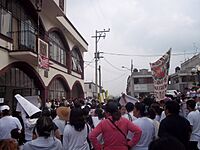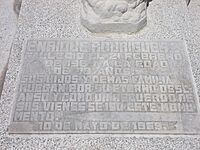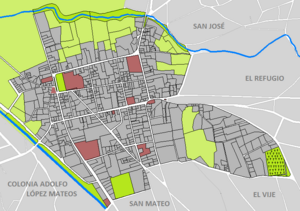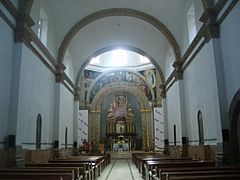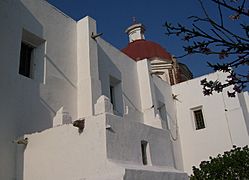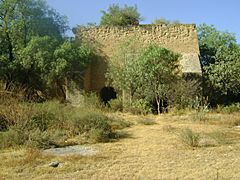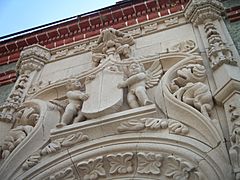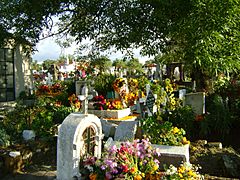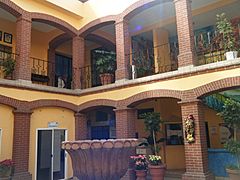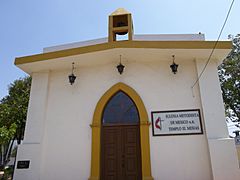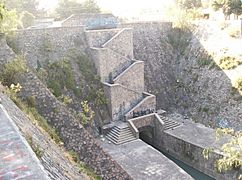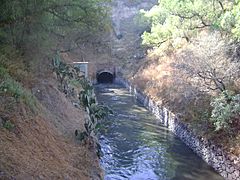Santiago Tequixquiac facts for kids
Quick facts for kids
Santiago Tequixquiac
Nthehe (in Otomi)
|
||
|---|---|---|
|
Municipal Seat
|
||

Town of Santiago Tequixquiac
|
||
|
||
| Country | ||
| State | State of Mexico | |
| Region | Zumpango Region | |
| Municipality | Tequixquiac | |
| Chichimec town | 1168 | |
| Spanish town | 1552 | |
| Municipal town | 1820 | |
| Area | ||
| • Total | 10.83 km2 (4.18 sq mi) | |
| Elevation
(of seat)
|
2,100 m (6,900 ft) | |
| Population
(2010)
|
||
| • Seat | 22,676 | |
| Time zone | UTC-6 (Central (US Central)) | |
| • Summer (DST) | UTC-5 (Central) | |
| Postal code (of seat) |
55650
|
|
| Website | http://www.tequixquiac.gob.mx/ | |
Santiago Tequixquiac is a town and the main city of the Tequixquiac municipality in the State of Mexico, Mexico. Its name comes from Nahuatl and means "place on tequesquite waters." In the Otomi language, it is called Nthehe. As of 2010, about 22,676 people lived in the town.
Contents
History of Tequixquiac
The area where Tequixquiac is located has been home to people for a very long time. Scientists have found old tools and items from about 12,000 years ago! People likely settled here because there were many streams and springs, which made it a good place to live, grow food, and raise animals.
The town of Tequixquiac was founded by the Chichimeca people in 1168 A.D. Over the years, different groups ruled the town, including the Toltecs and the Tepanecas. The last group to take control before the Spanish arrived were the Aztecs. This happened in 1415 when the Aztec ruler Chimalpopoca conquered the area.
Tequixquiac was part of the Aztec Empire and had to pay taxes to the lord of Tacuba. Even though they were part of the Aztec Empire, the town still had its own leaders. The people of Tequixquiac before the Spanish conquest were known for being honorable and skilled in areas like medicine, education, and building.
Spanish Arrival and New Beginnings
After the Aztec Empire fell to the Spanish, the land around Tequixquiac was given to two Spanish soldiers, Martín López and Andrés Núñez. In this area, along with nearby towns, local people worked hard to extract lime, a material used in building.
In 1552, some local families were moved from their lands to make space for more Spanish settlers and new Christians from Spain and Portugal. The Spanish government wanted to build new churches and gather the local people around them. One of these churches was the Temple of Santiago Tequixquiac. It was built in 1569 and became an official church parish in 1590.
Changes in the 19th and 20th Centuries
During a time when there was very little rain, a special statue called "Señor de la Capilla" (Our Lord of the Chapel) was brought to Tequixquiac from a nearby town. When the rain finally came, the statue was too heavy to move back, so it stayed in Tequixquiac. Many people believe it has brought good things to the town. The main church's roof was finished in 1856.
The first school in Tequixquiac was built in 1856 by Narciso Vargas in the San Miguelito neighborhood.
In the 1900s, making pulque (a traditional Mexican drink) was very important for the town's economy. A large farm called Hacienda of San Sebastián was a major producer. A railway line was built through Tequixquiac in 1917 to connect Mexico City with other parts of the country. However, it was taken apart in 1945.
Tequixquiac Today
Since the 1950s, Santiago Tequixquiac has grown and become more like a city, as it is now part of the Mexico City Metropolitan Area. This growth has brought some challenges, especially in newer areas. These areas, often called "agricultural colonies," sometimes have issues with land ownership, urban planning, and basic services like water, streetlights, and paved roads. There has been a lot of population growth in these areas, sometimes leading to poverty in natural or farming lands.
Santiago Tequixquiac still has many farms and open spaces between its urban areas. However, more people are moving here from other places. The local people sometimes face challenges with safety and crime.
Geography of Tequixquiac
Santiago Tequixquiac is the main town and the most populated place in its municipality. The town is divided into four main neighborhoods, called barrios, and one agricultural community, known as a colonia ejidal.
A large artificial channel called the Gran Canal de Desagüe de Ciudad de México (Great Drainage Canal of Mexico City) runs through Santiago Tequixquiac. It connects with natural rivers. There's also a smaller river, the Río Salado de Hueypoxtla, which flows through the town and is used to water farm fields.
The town is located on a small hill called El Vije (or Mbixe in Otomi), with other hills nearby like Taxdho and Gumisha (B'omitsa). The original Otomi name for the old village was Nthehe. The Aztec name, Tequixquiac, means "place on tequesquite waters," referring to a type of salt found in the water.
People of Tequixquiac

Most people in Tequixquiac are Mestizo, meaning they have a mix of Indigenous and European (from Spain and Portugal) heritage. The first group to live here were the Otomis. Later, the Aztecs, or Mexicas, lived here until the Spanish conquest. The first Europeans to settle in the town were soldiers from Spain and Portugal who came with Hernán Cortés. Some of these were "New Christians," Jewish people who had converted to the Roman Catholic religion.
After Mexico became independent, English miners came to the area from places like Pachuca and Real del Monte. They helped build the Great Channel of Mexico City Waters. Many people from other Mexican states, such as Oaxaca, Veracruz, Puebla, and Hidalgo, also came to work on this important project. This led to many mixed families and the population grew.
However, during the Mexican Revolution, many people died in the war. Throughout the 20th century, people faced poverty and a lack of jobs. Many moved to northern Mexico, the United States, or Mexico City to find work. In the 1980s, the population grew again, and the quality of life for the people improved.
In 2010, the village of Santiago Tequixquiac had 22,676 residents.
Culture and Landmarks
Historical Monuments
- Saint James Apostle Parish is the most important building in Santiago Tequixquiac. It is located in the main square, Cuauhtémoc Plaza. This church was built over many years. Its entrance area is a large stone space with a cross that mixes Christian and Indigenous symbols. The front of the church has two beautifully decorated doorways with stone carvings that also show Indigenous symbols. The church and the town are named after Saint James the Apostle.
- El Calvario Chapel is a Catholic chapel built in 1796 for religious activities of the Indigenous people.
- Great Channel of Tequixquiac is a large water channel built in 1937 as part of Mexico City's water system.
- Municipal House of Tequixquiac is the local government building, also located in Cuauhtémoc Main Plaza. Inside, there are murals that show the history of the municipality, from ancient times to the 20th century.
- El Mesias Methodist Church of Tequixquiac was the first Protestant church built in Tequixquiac. It was for English mine workers who came from Real del Monte and Pachuca to help build the second part of the Great Canal in 1872. The church was built in downtown Tequixquiac in 1901.
- Casa de los Padres (House of the Priests) was a home first lived in by a Catholic priest. It was built in 1930 in an old Spanish style.
- Old Cemetery This cemetery was built in 1920. Many people who had been buried at the Saint James Apostle Parish were moved here.
- Great Channel of El Tajo This channel was built in different stages and was officially opened in 1900 by President Porfirio Díaz as part of Mexico City's water system.
- Calcium Oxide Horns and Chimney These structures were built to help start the tunnels of the Great Channel of Mexico City.
Gallery
Notable People
- Fortino Hipólito Vera y Talonia (1812-1889), a philosopher and writer who became a bishop.
- Jorge Sánchez García (1943), a leader, activist, and politician.
See also
 In Spanish: Santiago Tequixquiac para niños
In Spanish: Santiago Tequixquiac para niños





